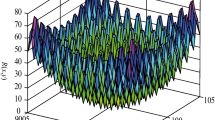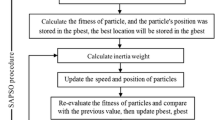Abstract
A Bayesian importance sampling method is developed to efficiently and accurately calibrate the parameters of non-linear and non-Gaussian system models. The unscented importance sampling (UIS) consists of two stages. The first stage uses the latest monitoring data to generate a Gaussian approximation of the true posterior distribution of the uncertain parameters and utilizes the measurement update stage of the unscented Kalman filter (UKF) to approximate the posterior. The second stage of UIS uses a mixture of approximate posterior computed in the first stage and a heavy tailed distribution as the proposal distribution for Bayesian importance sampling. UIS is repeated whenever new monitoring data becomes available. Two case studies were developed to study the UIS method and to compare it UKF and importance sampling (IS) methods: a non-linear analytical system model and synthesized CO2 injection model using a numerical multi-phase flow simulator. In analytical case study, it is shown that UIS is more accurate than both UKF and traditional IS with static proposal and the relative accuracy of the UIS over traditional IS increases with dimensionality of the parameter space. The higher accuracy of UIS compared to UKF and traditional IS with static proposal is also shown in the CO2 injection case study. It is also shown that increasing number of samples and a defensive mixture distribution with a mixture ratio between 0.1 and 0.25 enhances the performance of UIS.














Similar content being viewed by others
Notes
For a discrete parameter space, all integrals will be replaced by summation.
References
Aanonsen SI, Reynolds AC (2009) The ensemble Kalman filter in reservoir engineering–a review. SPE Journal 14(3):393–412
Alshuhail A, Lawton D, Isaac H (2009) Seismic characterizations of the Nisku formation. University of Calgary, Calgary
Ambadan JT, Tang Y (2009) Sigma-point Kalman filter data assimilation methods for strongly nonlinear systems. J Atmos Sci 66:261–285
Arulampalam MS, Maskell S, Gordon N, Clapp T (2002) A tutorial on particle filters for online nonlinear/non-gaussian bayesian tracking. IEEE Trans Signal Process 50(2):174–188
Bhowmik S, Mantilla CA, Srinivasan S (2011) Tracking CO2 plume migration during geologic sequestration using a probabilistic history matching approach. Stoch Environ Res Risk Assess 25:1085–1090
Cappé O, Guillin A, Marin JM, Robert CP (2004) Population Monte Carlo. J Comput Graph Stat 13(4):907–929
Cappé O, Douc R, Guillin A, Marin JMRCP (2008) Adaptive importance sampling in general mixture classes. Stat Comput 18(4):447–459
Chadwick R et al (2004) 4D seismic imaging of an injected CO2 plume at the Sleipner Field, Central North Sea. In: Davies R (ed) 3D Seismic technology: application to the exploration of sedimentary basins. Geological Society, London, pp 311–320
Chen Z (2003) Bayesian filtering: from Kalman filters to particle filters, and beyond. Statistics 182:1–69
Douc R, Guillin A, Marin JM, Robert CP (2007) Minimum variance importance sampling via population Monte Carlo. ESAIM: Probab Stat 11:427–447
Espinet AJ, Shoemaker CA (2013) Comparison of optimization algorithms for parameter estimation of multiphase flow models with application to geological carbon sequestration. Adv Water Resour 54:133–148
Evensen G (1994) Sequential data assimilation with nonlinear quasi-geostrophic model using Monte Carlo methods to forecast error statistics. J Geophys Res 99(C5):143–162
Freifeld B et al (2005) The U-Tube: a novel system for acquiring borehole fluid samples from a deep geologic CO2 sequestration experiment. J Geophys Res 110(B10)
Hall B (2012). Bayesian inference, Cran. R-project, LaplacesDemon Package. http://cran.rproject.org/web/packages/LaplacesDemon/vignettes/BayesianInference.pdf
Hesterberg T (1995) Weighted average importance sampling and defensive mixture distributions. Stanford University, Stanford
Hongjun Z, Xinwei L, Yanfang C, Xiaoliang Z (2010) Sensitivity analysis of CO2 sequestration in saline aquifers. Petroleum Science 7:372–378
Houtekamer PL et al (2005) Atmospheric Data Assimilation with an Ensemble Kalman Filter: results with Real Observations. Mon Weather Rev 133(3):604–620
Hoversten G et al (2004) Cross-well electromagnetic seismic imaging: an examination of coincident surveys at a steam flood project. Geophysics 69:406–414
Johnson J, White D (2012). History matching and performance validation. In: Best practices for validating CO2 geological storage: observations and guidance from the IEAGHG Weyburn-Midale CO2 Monitoring and Storage Project, vol 254. Geoscience Publishing, Edmonton, p 215
Julier S, Uhlmann JK (1996) A general method for approximating nonlinear transformations of probability distributions. University of Oxford, Oxford
Kaipio JP, Somersalo E (2007) Statistical inverse problems: discretization, model. J Comput Appl Math 198(2):493–504
Kalman R (1960) A new approach to linear filtering and predicition problems. J Fluids Eng 82:35–45
Kim IS (2011) Large scale data assimilation with application to the Ionosphere–thermosphere, vol l. Proquest, Umi Dissertation Publishing, Ann Arbor
Kopp A et al (2010) A contribution to risk analysis for leakage through abandoned wells in geological CO2 storage. Adv Water Resour 33:867–879
Lavoie R, Keith D (2010) Executive summary of Wabamun Area CO2 Sequestration Project (WASP). University of Calgary, Calgary
Lawton D (2010) Carbon capture and storage: opportunities and challenges for geophysics. CSEG Rec 35(6):7–10
Lawton D et al (2010) Recommendations for injection and storage monitoring, Wabamun Area CO2 Sequestration Project (WASP). University of Calgary, Calgary
Leisenring M, Moradkhani H (2011) Snow water equivalent prediction using Bayesian data assimilation methods. Stoch Environ Res Risk Assess 25(2):253–270
Li Z, Fall M (2013) A modeling tool for assessment of potential groundwater contamination in response to CO2 leakage from geological disposal of CO2. In: 3rd Climate change technology conference, CCTC 2013, Montreal Canada. Paper no. 156972894
Li X, Cardiff MA, Kitanidis PK (2004) Parameter estimation in nonlinear environmental problems. Stoch Environ Res Risk Assess 24(7):1003–1022
Liu X, Cardif MA, Kitanidis PK (2010) Parameter estimation in nonlinear environmental problems. Stoch Env Res Risk Assess 24(7):1003–1022
Marshall A (1956) The use of multi-stage sampling schemes in Monte Carlo computations. Wiley, New York, pp 123–140
Mesbah A, Huesmana A, Kramerb H, Van den Hofa P (2011) A comparison of nonlinear observers for output feedback model-based control of seeded batch crystallization processes. J Process Control 21(4):652–666
Naevdal G, Aanonsen SI, Vefring EH (2005) Reservoir monitoring and continuous model updating using ensemble Kalman filter. SPE Journal 10(1):66–74
Nooner S et al (2007) Constraints on the in situ density of CO2 within the Utsira Formation from time-lapse seafloor gravity measurements. Int J Greenhouse Gas Control 1:198–214
Nordbotten J et al (2012) Uncertainties in practical simulation of CO2 storage. Int J Greenhouse Gas Control 9:234–242
Oladyshkin S, Class H, Helmig R, Nowak W (2011) An integrative approach to robust design and probabilistic risk assessment for CO2 storage in geological formations. Comput Geosci 15:565–577
Owen A, Zhou Y (1998) Safe and effective importance sampling. Stanford University, Stanford
Price P, Oldenburg C (2009) The consequences of failure should be considered in siting geological carbon sequestration projects. Int J Greenhouse Gas Control 3:658–663
Raikes S et al (2008) Integration of 3D Seismic with satellite imagery at In Salah CO2 Sequestration Project, Algeria. Society of Exploration Geophysicists (2008 SEG Annual Meeting), Las Vegas
Reichle RH, McLaughlin DB, Entekhabi D (2002) Hydrologic data assimilation with the ensemble Kalman filter. Mon Weather Rev 130(1):103–116
Rougier J (2008) Formal Bayes methods for model calibration with uncertainty. In: Applied uncertainty analysis for flood risk management, vol l. Imperial College Press, London
Sarkarfarshi M, Malekzadeh FA, Gracie R, Dusseault MB (2014) Parametric sensitivity analysis for CO2 geosequestration. Int J Greenhouse Gas Control 23:61–71
Sato K (2011) Value of information analysis for adequate monitoring of carbon dioxide storage in geological reservoirs under uncertainty. Int J Greenhouse Gas Control 5:1294–1302
Schlumberger (2013) ECLIPSE technical description version 2013.2. s.l.:s.n
Shu Q, Kemblowski MW, McKee M (2005) An application of Ensemble Kalman Filter in integral-balance subsurface modeling. Stoch Environ Res Risk Assess 19:361–374
Smith PJ, Shafi M, Gao H (1997) Quick simulation: a review of importance sampling techniques in communications systems. IEEE J Sel Areas Commun 15(4):597–613
Soreide I, Whitson C (1992) Peng Robinson predictions for hydrocarbons, CO2, N2 and H2S with pure water and NaCl brine. Fluid Phase Equilib 77:217–240
SPE International (n.d.) Permeability determination. http://petrowiki.org/Permeability_determination#Determining_permeability. Accessed 2013
Stedinger J, Vogel R, Lee S, Batchelder R (2008) Appraisal of the generalized likelihood uncertainty estimation (GLUE) method. Water Resour Res 44:W00B06
Tavakoli R et al (2013) Comparison of ensemble filtering algorithms and null-space Monte Carlo for parameter estimation and uncertainty quantification using CO2 sequestration data. Water Resour Res 49:1–20
Terejanu GA (2011) Unscented Kalman filter tutorial. University at Buffalo, Buffalo
van der Merwe R, Doucet A, De Freitas N, Wan E (2000) The unscented particle filter. In: Proceeding of advances in neural information processing systems (NIPS), pp 584–590
van Leeuwen PJ, Evensen G (1996) Data assimilation and inverse methods in terms of a probabilistic formulation. Mon Weather Rev 124:2898–2913
Walton FB, Tait JC, LeNeveu D, Sheppard MI (2004) Geological storage of CO2: a statistical approach to assessing performence and risk. Gas Control Technologies, Vancouver
Wan E, van der Merwe R (2001) The unscented Kalman filter, vol l. Wiley, New York
Acknowledgments
The authors acknowledge funding from the Natural Science and Engineering Research Council of Canada (NSERC) through Carbon Management Canada (CMC) and from NSERC’s Discovery Grant program. Lastly, we would like to thank our colleagues Drs. James Craig and Maurice Dusseault for their moral support and academic insights.
Author information
Authors and Affiliations
Corresponding author
Rights and permissions
About this article
Cite this article
Sarkarfarshi, M., Gracie, R. Unscented importance sampling for parameter calibration of carbon sequestration systems. Stoch Environ Res Risk Assess 29, 975–993 (2015). https://doi.org/10.1007/s00477-014-0963-7
Published:
Issue Date:
DOI: https://doi.org/10.1007/s00477-014-0963-7




